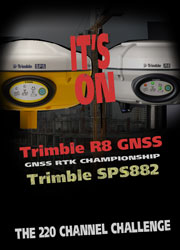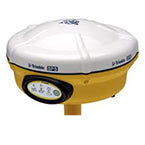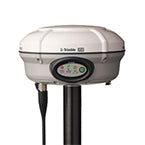At PositioningSolutions.com we receive a lot of questions regarding the differences between the Trimble R8 Model 3 vs SPS882 receivers, so we decided to put them to the test to determine which receiver you should buy.

Construction or Survey?
To get an understating why Trimble has produced two different GNSS receivers, we need to understand that there are two separate groups within Trimble. The Survey/ Geospatial group and the Construction - Heavy Civil group. The purpose of dividing the two markets is to provide better focus on the individual needs of their customers. The focus started with the controller software. Most surveyors that use Trimble products are familiar with Survey Controller software and have formal education in surveying. However, with the popularity of GPS growing in early 2000, Trimble realized that there was a demand for GPS for the non-surveyor, so they developed an easier to use software called SCS900 (Site Controller Software) for the Construction market. As the popularity of GPS and SCS900 grew, Trimble decided to divide the two groups with the purpose of developing products that better meet their customer’s needs.
Datasheet Review
We started with the datasheets provided on Trimbles website www.trimble.com Both receivers use Trimble's Maxwell 6 chip's and have 220 channels allowing both receivers to track and provide corrections for up to 44 satellites. Per the datasheets, both receivers list the same shock, vibration, and IP67 ratings. Both have Bluetooth, Lemo and serial ports for comminication. There is a 5 mm difference listed in vertical accuracy and 2 mm in horizontal, but baseline lengths are not mentioned on either datasheet - which is the most likely reason for the difference. Both receivers list; 1, 2, 5, 10, and 20 Hz positioning capability as well as CMR+, CMRx, RTCM 2.1, RTCM 2.3, RTCM 3.0, RTCM 3.1 input and output protocols.
Both receivers are VRS capable and both have 57MB of internal data storage (for static survey). And both receivers, according to Trimble’s literature, are “committed to the next generation of modernized GNSS configurations by providing Galileo-compatible products, well in advance of Galileo system availability”. So what gives? What is the difference?
Trimble SPS882 Specifications

- 220-channel receiver
- Maxwell 6 chipset
- GPS Tracking: L1C/A,L1/L2/L2C - Upgradable to L5
- GLONASS Tracking: L1/L2C/A, L1/L2P Full Cycle Carrier
- SBAS L1 C/A, L5
- Galileo GIOVE-A and GIOVE-B *
REAL-TIME KINEMATIC (RTK) POSITIONING
- Horizontal accuracy . . . . . . 8 mm + 1 ppm RMS (0.026 ft + 1 ppm RMS)
- Vertical accuracy . . . . . . . . . . 15 mm + 1 ppm RMS (0.05 ft + 1 ppm RMS)
SPS882 Notes:
The SPS882 is a familiar design that utilizes the same housing and radome as the older R8 Model 2, trading the light grey color for yellow. According to the datasheets, the SPS882 lists the same Maxwell 6 chipset, but slightly better RTK accuracy, but again, the baseline length is not provided - which I assume accounts for the difference. The SPS882 lists EVEREST™ multipath signal rejection technology, which dates back to the old 4000 series receivers. The R8 does not mention any use of EVEREST.
The main thing to note about the SPS882, is that while it lists all of the same abilities as the R8-3, it requires each option to be purchased separately. This allows the user to purchase only what they intend to use. Additional features can be added on at any time. As an example, if the user intends to use the SPS882 as a base station only - they can save about $9,000 over what a new R8-3 costs!
- Precise RTK is an option (optional low-precision mode available)
- Base station functionality is an option
- Rover functionality is an option
- Datalogging, Precision and TX (radio) are all options
* Galileo tracking is not mentioned on the specification sheets, but according to Trimble "the Trimble SPS882 is capable of tracking the experimental Galileo GIOVE-A and GIOVE-B test satellites for signal evaluation and test purposes"
R8 GNSS Model 3 Specifications:
- 220 channel receiver
- Maxwell 6 chipset
- GPS Tracking: L1C/A, L2C, L2E (Trimble method for tracking L2P), L5
- GLONASS Tracking: L1C/A, L1P, L2C/A (GLONASS M only), L2P
- SBAS: L1C/A, L5
- Galileo GIOVE-A and GIOVE-B
REAL-TIME KINEMATIC (RTK) POSITIONING
- Horizontal accuracy. . . . . . . . . . . 10 mm + 1 ppm RMS
- Vertical accuracy. . . . . . . . . . . . 20 mm + 1 ppm RMS
R8 GNSS Notes:
The R8 Model 3 comes with all options enabled from the factory.
Per the product specification sheets, the R8-3 GNSS uses R-Track with Signal Prediction™ technology. R-Track is not mentioned on the 882 datasheet, but we believe both receivers use R-Track - as per this R-Track WhitePaper - is the technology Trimble developed in 2003 "in response to the DOD's announcement of Modernization of GPS" which included L2C and L5 .
The internal radio offerings are different - the R8 GNSS offers two radio options - either an internal UHF radio, or GSM cellular modems, while the SPS882 offers three internal radio options - UHF, 900Mhz, or 2.4Ghz (wi-fi).
Equipment used for field test
- R8 GNSS Model 3 with TDL450H (base)
- R8 GNSS Model 3 w/ 450-470 MHz (rover)
- SPS882 w/ 450-470 MHz (rover)* w/ Precise RTK and GLONASS options enabled
- TSC2 w/ Survey Controller 12.51
- Tripod for base and TDL450 (5 feet height)
- Standard 2M rover rod
- Trimble S6, 5" instrument
Field test - R8 GNSS (M3) vs SPS882
 We only concerned ourselves with fixed RTK measurements. Both receivers were tested at 12 km from the base station. The base station used for testing was a Trimble R8-3 GNSS sending CMRx™ corrections via TDL450H radio. We used Trimble Survey Controller ver 12.51 software loaded on a TSC2 for testing both rover receivers. (this was 2010).
We only concerned ourselves with fixed RTK measurements. Both receivers were tested at 12 km from the base station. The base station used for testing was a Trimble R8-3 GNSS sending CMRx™ corrections via TDL450H radio. We used Trimble Survey Controller ver 12.51 software loaded on a TSC2 for testing both rover receivers. (this was 2010).
We used our Trimble S6 instrument to compare deltas. For this test, we only concerned ourselves with RTK measurements that were outside the horizontal and vertical specifications. We were not trying to chase millimeters.
We took several RTK measurements over different times of the day. The receivers were tested at the same locations, on the same point. Observations were set to 20 seconds each. As all RTK observations go, some are more accurate than others, but none measured out of the 20 mm vertical and 15 mm horizontal specifications.
Both receivers were tested in various conditions; wide open space, under light tree canopy, and in a parking lot, surrounded by several buildings that varied in height (a typical business park). Neither receiver fared better in any condition, nor at any distance within the 12 km baseline - and initialization times were within seconds of each other. The R8 did initialize faster almost every time – but within seconds the 882 was also locked and ready.
Both of these receivers performed extremely well in every environment. To push our test further, we ventured into areas that had more tree canopy and other obstructions of the sky, including inside our covered warehouse, and up to the trunk of large tall oak trees...areas not intended to be measured by high-precision satellite tracking devices, at least not in 2010.
The ability of either receiver to maintain it’s RTK fix in these environments was amazing! Every step of the way, we we verified accuracies with the S6.
Summary
Our field test showed that both receivers performed flawlessly and simply got the job done. The choice seems to come down to your budget and intended use. The R8’s have every option you will ever need enabled from the factory, and the SPS882 allows you to purchase just the options you need. With all options enabled, the SPS882 is just under the price of an R8 (New list prices). However – if you option one 882 as a RTK rover and the other as a base station – you can save a considerable amount of money – over $10,000 per kit!
In the end, both receivers are solid products and provide the performance that you expect from Trimble. Either way you go, the clear winner is you.
Final notes
*Originally written in 2010** Today, Access field software replaced Survey Controller and does not require an option code to operate SPS hardware.
In order for our test receivers to work with either software, an option code was required for Survey Controller version 12.49 to operate the full set of features in the SPS882 receiver. This code was free of charge from Trimble. SCS900 version 2.9 software did not require any code to operate the R8 GNSS receiver. Additionally, Survey Controller 12.xx will start the SPS882 as a base station without the code – only requiring the code to use the SPS882 as a rover.

